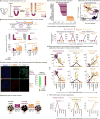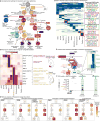Mapping the Pairwise Choices Leading from Pluripotency to Human Bone, Heart, and Other Mesoderm Cell Types
- PMID: 27419872
- PMCID: PMC5474394
- DOI: 10.1016/j.cell.2016.06.011
Mapping the Pairwise Choices Leading from Pluripotency to Human Bone, Heart, and Other Mesoderm Cell Types
Abstract
Stem-cell differentiation to desired lineages requires navigating alternating developmental paths that often lead to unwanted cell types. Hence, comprehensive developmental roadmaps are crucial to channel stem-cell differentiation toward desired fates. To this end, here, we map bifurcating lineage choices leading from pluripotency to 12 human mesodermal lineages, including bone, muscle, and heart. We defined the extrinsic signals controlling each binary lineage decision, enabling us to logically block differentiation toward unwanted fates and rapidly steer pluripotent stem cells toward 80%-99% pure human mesodermal lineages at most branchpoints. This strategy enabled the generation of human bone and heart progenitors that could engraft in respective in vivo models. Mapping stepwise chromatin and single-cell gene expression changes in mesoderm development uncovered somite segmentation, a previously unobservable human embryonic event transiently marked by HOPX expression. Collectively, this roadmap enables navigation of mesodermal development to produce transplantable human tissue progenitors and uncover developmental processes. VIDEO ABSTRACT.
Copyright © 2016 Elsevier Inc. All rights reserved.
Figures







Comment in
-
Mesoderm, Cooked Up Fast and Served to Order.Cell Stem Cell. 2016 Aug 4;19(2):146-148. doi: 10.1016/j.stem.2016.07.007. Cell Stem Cell. 2016. PMID: 27494669 Free PMC article.
References
Publication types
MeSH terms
Substances
Grants and funding
LinkOut - more resources
Full Text Sources
Other Literature Sources
Molecular Biology Databases

